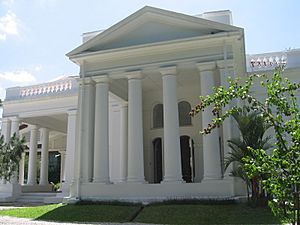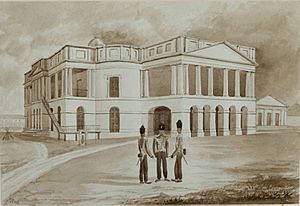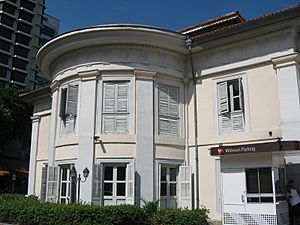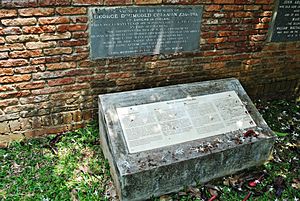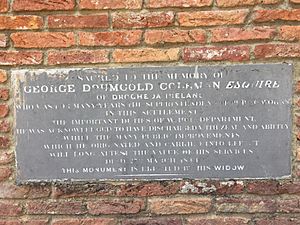George Drumgoole Coleman facts for kids
Quick facts for kids
George Drumgoole Coleman
|
|
|---|---|
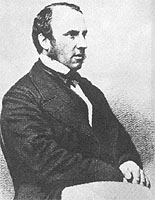
Portrait of Drumgoole Coleman (1800s)
|
|
| Born | 1795 |
| Died | 27 March 1844 (aged 48–49) Coleman House, Singapore
|
| Nationality | Irish |
| Occupation | Architect |
| Spouse(s) |
Takoye Manuk
(m. 1829–1844)Maria Frances Vernon
(m. 1842–1844) |
| Children | Meda Elizabeth Coleman (daughter) George Vernon Coleman Napier (son) |
| Parent(s) | James Coleman (father) |
| Buildings | Caldwell House Armenian Church St Andrew's Cathedral (first church, demolished) Old Parliament House Istana Kampong Glam (alleged) Coleman House (demolished) |
| Projects | Old Christian Cemetery Raffles Institution |
| Design | Residency House (demolished) Telok Ayer Market (second market, demolished) |
George Drumgoole Coleman (1795 – 1844) was an Irish architect and engineer. He played a huge part in designing and building many important structures in early Singapore. Singapore was founded by Sir Stamford Raffles in 1819. Coleman helped shape the look of the new city.
Only a few of his original buildings still stand in Singapore today. The most famous ones include the Armenian Church of Saint Gregory the Illuminator, Old Parliament House (which was once Maxwell's House), and Caldwell House.
Contents
Early Life and Training
George Drumgoole Coleman was born in Drogheda, County Louth, Ireland. His father, James Coleman, was a merchant who also sold building materials. George learned to be a civil architect, which means he designed buildings and public structures.
Building Singapore
Starting in Asia
In 1815, when he was just 19, Coleman left Ireland for Calcutta, India. There, he started his career designing homes for wealthy merchants. Later, he was invited to build churches in Batavia (now Jakarta, Indonesia). The churches were never built, but Coleman spent two years working in Java.
Arriving in Singapore
Coleman then met Sir Stamford Raffles and traveled to Singapore, arriving in June 1822. Raffles trusted Coleman to help plan the new town. Coleman was in charge of laying out the town center, creating roads, and building many beautiful structures.
He also oversaw the creation of the Christian Cemetery in late 1822. While Raffles was away, Coleman designed the Residency House for him. It was made of timber with a thatched roof. Raffles approved the house, and it was finished in January 1823 on Singapore Hill. Coleman later expanded this house to be the home for future leaders of Singapore.
Key Projects and Designs
After a short time in Java, Coleman returned to Singapore in 1825. He designed a large, grand house for David Skene Napier, Singapore's first magistrate. He also designed a grand building for merchant John Argyle Maxwell. This building was later rented by the government and became part of the Parliament House of the Republic of Singapore. Coleman designed it in a style called Palladian, but he added verandas and wide eaves to keep it cool in the tropical climate.
In 1827, Coleman became a Revenue Surveyor, mapping out land for shop-house lots in the town. In 1828, he designed and built his own home, Coleman House, which was finished in 1829.
Coleman also worked as a Topographical Surveyor, carefully mapping the islands and coastlines around Singapore's new harbor. This helped plan for future defenses. From 1833 to 1835, he was the Superintendent of Public Works and Convicts, overseeing construction projects and managing convict labor. He led the building of North Bridge Road and South Bridge Road.
In 1835, Coleman helped start the Singapore Free Press & Mercantile Advertiser newspaper with William Napier and others.
Coleman's Lasting Buildings
While Coleman designed many private homes, only a few of his confirmed designs still exist today. These include the Parliament House (though it has changed a lot) and Caldwell House, which is now part of CHIJMES on Victoria Street. The Istana Kampong Glam is also thought to be his work, but it's not fully confirmed.
One of his most famous surviving works is the Armenian Church of Saint Gregory the Illuminator on Hill Street, built in 1835. He also built the first Anglican church in Singapore, St Andrew's, starting in 1835. However, this church was taken down in the 1850s because it was damaged by lightning.
Coleman also helped finish and expand the Raffles Institution, a school building. This building was later demolished in 1972. Another important building he designed was the Telok Ayer Market on the waterfront in 1835. It was later taken down because of land reclamation, but the new market, Lau Pa Sat, kept the original octagonal shape Coleman designed.
|
|
Personal Life
Coleman had a daughter named Meda Elizabeth Coleman, born in Singapore in 1829. She was christened in 1837.
After 15 years of continuous work in Asia, Coleman left for England in 1841. He married Maria Frances Vernon in Ireland in 1842. However, Coleman found it hard to settle down in Europe and quickly returned to Singapore with his new wife in late 1843. They had a son, George Vernon Coleman, born in December 1843.
Death and Legacy
Coleman died in his house on March 25, 1844, at the age of 49, due to a fever. He was buried in the Old Christian Cemetery at the foot of Government Hill, which is now known as Fort Canning Hill.
After his death, Coleman's widow married William Napier. Coleman's infant son, George, passed away at sea in 1848 when he was only four years old. His daughter, Meda Elizabeth Coleman, lived until October 1907 in Singapore.
Coleman's grave and others were later moved between 1954 and 1965 when the cemetery became a park. His gravestone is now part of a memorial at Fort Canning Park. In 1965, Coleman's own home, Coleman House, was taken down to make way for the Peninsula Hotel.
George Drumgoole Coleman's name is still remembered in Singapore through several places:
- Coleman Bridge
- Coleman Place
- Coleman Street
- Coleman House (his former residence)
Sources
- T.H.H. Hancock (1986), Coleman's Singapore, The Malaysian Branch of the Royal Asiatic Society in association with Pelanduk Publications.
- Lee Geok Boi (2002), The Religious Monuments of Singapore, Landmark Books, ISBN: 981-3065-62-1.
- Victor R Savage, Brenda S A Yeoh (2003), Toponymics – A Study of Singapore Street Names, Eastern Universities Press, ISBN: 981-210-205-1.
- Nadia Wright (2003), Respected Citizens: The History of Armenians in Singapore and Malaysia, Amassia Publishing. ISBN: 0-9751082-0-4.


